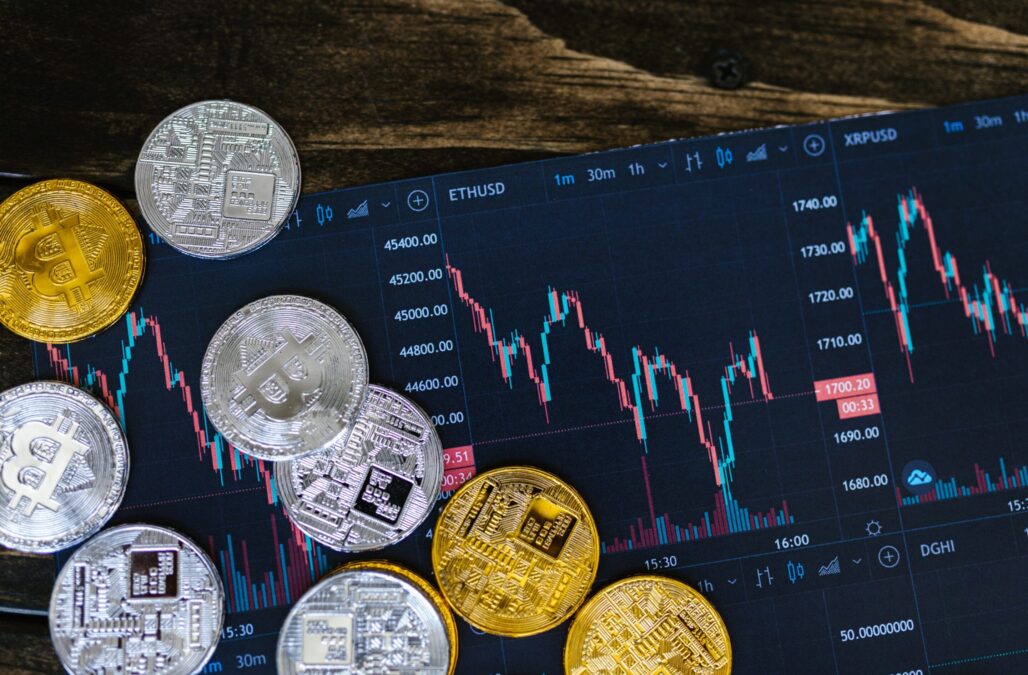Everyone everywhere is talking about crypto these days, and some financial pundits have suggested that the crypto space is in the same place the internet was back in 2000—about to explode. But how can you leverage it for profit?
7 Best Crypto Trading Strategies
- Day Trading
- Range Trading
- Scalping
- Arbitrage
- Dollar Cost Averaging
- Bitcoin Futures
- Participate in the Blockchain
Cryptocurrency is a type of digital coinage that can be used to facilitate transactions. It’s not tied to any government or central bank, so it’s totally anonymous. Moreover, its ledger is not recorded in one centralized place, but rather, a decentralized along a network called the blockchain.
This means there is no way for an unscrupulous party to come along and falsify information because the same information is everywhere…and at the same time nowhere. If it sounds complicated, it is. But like any other asset, there are excellent opportunities to capitalize on the rise and fall of cryptocurrency values through crypto day trading, range trading, or similar strategies or investments. This is because, like any currency, crypto rises and falls in value. In fact, most of the activity around cryptocurrency involves trading and investing in it through the cryptocurrency market through a crypto exchange (there are multiple ones).
It’s not yet commonly used for transactions, but because the values go up and down, there are excellent opportunities to exercise the classic adage of buy low, sell high.
Infinity Investing Featured Event
In this FREE event you’ll discover how the top 1% use little-known “compounders” to grow & protect their reserves. Our Infinity team of experts show you how to be the best possible steward of your finances and how to make your money and investments work for you instead of you working for them. Regardless of your financial situation today, you’ll have a road map to get to where you want to be.
7 Best Crypto Trading Strategies
1. Day Trading Crypto
Day trading involves buying a particular crypto coin when its value is low, and selling it when its value is high. This strategy is basically the same thing day traders are doing on the stock market with securities, only in the crypto space they are doing with coins.
The problem with day trading crypto for most casual retail investors is that it’s next to impossible to predict the price movements of cryptocurrency unless you have a crystal ball—or software that can read algorithms and make predictions about crypto prices moving forward. Bitcoin trading may be the first thing that comes to mind when you hear about those who trade cryptocurrency, but there are plenty of other coins to trade, from popular ones like Ethereum and Dogecoin to the dozens of obscure coins that are popping up every day.
2. Range Trading Crypto
Range trading is similar to day trading, but where day trading involves entering and exiting positions within a matter of days or hours, range trading involves longer periods of time. Because range trading is leveraging longer periods of time, there is less immediate need to capitalize on short term price swings, which can mean that range trading is less risky.
That said, it still more often than not requires the assistance of algorithmic tools to read market trends in order to buy the dip and then unload the asset at a higher price, whether you’re talking about crypto, stocks, futures, or even collectibles.
One benefit to range trading is that many platforms, such as Coinbase Pro, will let you engage in automated trading by setting stop losses. These stop losses (or limit orders) will dump your assets when they hit a certain price to avoid losing out on the profit that range trading has yielded.
3. Scalping Crypto
In the days of the Old Wild West, scalping was the practice of swooping in on an unsuspecting settlement and capturing enemy scalps. While crypto scalping is not as physically violent, it can be as brutal for those who don’t know what they are doing.
Even for those who do, a crypto scalping strategy can be one punctuated by losses and disappointments. But if you can successfully make it as a crypto scalper, you will be actively trading over the span of seconds. This is because you are profiting on the tiniest swings in price, which also necessitates trading at larger volumes.
In most cases, it also means you will need the assistance of some crypto trading bots. A crypto bot can help in instances like these because it is better equipped to analyze algorithmic input and make split-second decisions. For these reasons, scalping is probably off limits to most crypto traders, unless they can engage in high trading volume and have the capital to invest in high level software and hardware (or the programming knowledge to build it).

4. Arbitrage on Cryptocurrency
Unlike stocks, cryptocurrency is bought and sold on a variety of crypto exchanges. In this way, the exchanges themselves are somewhat similar to the brick-and-mortar banking business—you can cash a check at any bank, for instance. But this decentralization also offers another interesting crypto investing strategy: arbitrage.
This is where you buy a crypto coin in one marketplace and sell it in a different one for profit. Of course, in order for this to work you have to be paying attention to all the marketplaces in real time. Many of these marketplaces will have different layouts and operating procedures, so becoming familiar with all of them can make a world of difference when you are quickly trying to execute arbitrage between one marketplace and another.
5. Dollar Cost Averaging on Your Purchase of Cryptocurrency
Dollar cost averaging is more of an investing strategy than a trading strategy. If you don’t know the difference between trading vs investing, basically trading is a short game, while investing is a long one.
Dollar cost averaging involves putting the same amount of capital into an asset class consistently every period, whether that period is a week, two weeks, month, or year. In this case, you would be putting a weekly amount of fiat currency into the cryptocurrency of your choice; or perhaps a crypto mutual fund or crypto ETF.
The idea of dollar cost averaging is that while markets go up and down, over time, they generally go up. Over time, the average result is going to be one of growth.
6. Bitcoin Futures
Many of the crypto investor strategies we’ve outlined above involve position trading based on the market position. But many a day trader working with crypto funds can profit from margin trading.
As a cryptocurrency trading strategy, margin trading is not much different than it is with stocks. Oftentimes, it is paired with a type of derivative (meaning, an asset that is secondary to an underlying asset) called futures or options. These are speculative contracts that give individuals the right (but not the obligation) to buy or sell crypto at a certain strike price. If the trader estimated correctly, this could result in a sweet opportunity that is only financially viable with a little bit of help—hence the need for margin (essentially borrowed money).
Some trading platform options can facilitate margin and options for cryptocurrency trading, such as Binance and Deribit. It’s important to keep in mind that this type of strategy, whether you’re doing it with stocks or crypto, adds a layer of complexity to the whole operation for swing traders. In some ways, it’s a great method for hedging risk because the option contract on crypto futures does not lock you into the obligation to buy the contract. In other ways, it can create more risk because margin trading is borrowed money.
If you’re interested in learning more about derivatives, options trading, and margin trading as it relates to the stock market, you might consider joining one of our weekly Stock Trading Rooms.
7. Participate in the Blockchain
In addition to crypto traders capitalizing on market movements, swing traders might also explore the idea of a different type of crypto asset: nodes.
To keep it simple, nodes are part of the blockchain that facilitates actual crypto transactions. In the past, this type of participation required hardware, and as the cryptocurrency asset aged, more hardware was required (you may have also heard this explained as crypto mining).
Now, however, opportunities to participate in the blockchain are cloud-based, meaning you don’t need the fancy hardware. You just need a little bit of capital to exchange coins, which you then use to purchase the nodes that facilitate transactions on the network. In return, the network will cut you a percentage of transactions facilitated.
Many of these opportunities do limit the amount of money you can withdraw on any given day in order to prevent people from crashing the system, but it is still an excellent opportunity with the potential of phenomenal returns. Finding the best cryptocurrency to participate in with nodes is as simple as doing a little Google research.
What is the Best Crypto Trading Strategy?
That depends on your level of expertise and risk appetite. If you have no idea what you are doing, you should learn more about cryptocurrency and day trading in general before doing something like scalping, arbitrage, or even range trading.
If you are a casual retail investor with a busy career who has no time to research these things, you can invest some of your earnings into a passive crypto strategy, like a mutual fund or ETF, that focuses on digital currency. Many banks and investment houses are starting to offer these opportunities to investors that want to capitalize on the recent advent of the crypto space but don’t fully understand it.
If you are familiar with day trading, perhaps in other contexts, like the stock market, or perhaps through additional derivatives, like options contracts and short selling, day trading crypto might not be a bad idea. The important thing to keep in mind is that day trading cryptocurrency is going to be a lot different than day trading stocks because there are many different technical factors and calculations involved, such as navigating the marketplaces and exchanges.
Since crypto is regarded as an asset, that means crypto has a taxable value based on capital gains or capital losses. If you exchange your crypto for another crypto or liquidate it for a fiat currency, your crypto will be subject to short-term capital gains tax or long-term capital gains tax, depending on how long you’ve held it. A short-term capital gains tax is applied to assets purchased and liquidated within less than a year, and a long-term capital gains tax is applied to assets that have been held for at least one year before liquidation.
There Are Many Different Cryptocurrency Strategies to Explore
The crypto space is exciting and growing, but not every type of strategy will work for everybody. If you want to learn more about crypto specifically, check out the updates and information in one of our weekly Cryptocurrency Rooms.
Remember, while cryptocurrency is exciting, there are plenty of other assets that will continue to offer great ROI potential, including stocks, bonds, precious metals, and real estate. You can learn more about investing in these assets and more by signing up for a free Infinity Investing Membership. Don’t put your financial future off another day—join today!
Bonus Video
Infinity Investing Featured Event
In this FREE event you’ll discover how the top 1% use little-known “compounders” to grow & protect their reserves. Our Infinity team of experts show you how to be the best possible steward of your finances and how to make your money and investments work for you instead of you working for them. Regardless of your financial situation today, you’ll have a road map to get to where you want to be.

